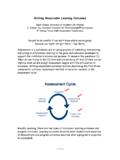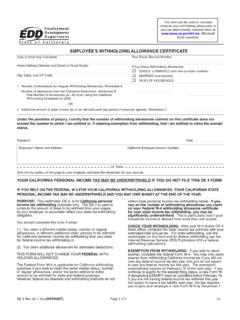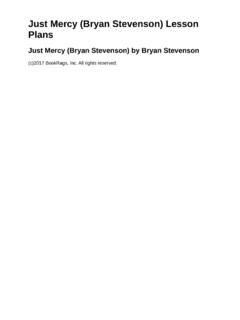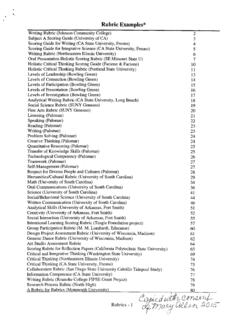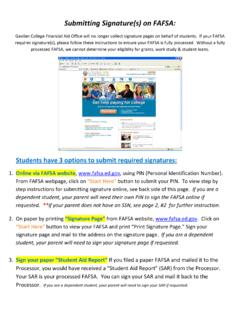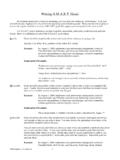Transcription of Writing Measurable Learning Outcomes - Gavilan …
1 Writing Measurable Learning Outcomes Sandi Osters, Director of Student Life Studies F. Simone Tiu, Assistant Director for Institutional Effectiveness 3rd Annual Texas A&M Assessment Conference You got to be careful if you don't know where you're going, because you might not get there Yogi Berra Assessment is a systematic and on-going process of collecting, interpreting, and acting on information relating to the goals and Outcomes developed to support the institution's mission and purpose. It answers the questions: (1).
2 What we are trying to do? (2) How well are we doing it? And (3) How can we improve what we are doing? Assessment begins with the articulation of Outcomes . Writing Measurable Outcomes involves describing the first three components: outcome , assessment method, criteria for success, in the assessment cycle. Assessment Cycle outcome Use of Assessment Results Method Assessment Criteria for Results Success Broadly speaking, there are two types of Outcomes : Learning Outcomes and program Outcomes . Learning Outcomes describe what students are expected to demonstrate and program Outcomes describe what a program is expected to accomplish.
3 1 of 10. Learning Outcomes Learning Outcomes describe what students are able to demonstrate in terms of knowledge, skills, and values upon completion of a course, a span of several courses, or a program. Clear articulation of Learning Outcomes serves as the foundation to evaluating the effectiveness of the teaching and Learning process. The Components of a Measurable Learning outcome . Three essential components of a Measurable Learning outcome are: Student Learning behaviors Appropriate assessment methods Specific student performance criteria / criteria for success When Writing a Measurable Learning outcome , it is important to: focus on student behavior use simple, specific action verbs select appropriate assessment methods state desired performance criteria Focus on Student Behavior.
4 Learning Outcomes are about what students are able to demonstrate upon completion of a course or a span of courses or a program. Learning Outcomes are not about what the instructors can provide but what the students can demonstrate. The following are not Learning Outcomes : Offer opportunities for students to master integrated use of information technology. The program will engage a significant number of students in a formalized language/cultural studies program. Students who participate in critical Writing seminars will write two essays on critical thinking skills.
5 Students will be exposed to exceptionality in Learning disabilities including visual and perception disabilities. Use Simple, Specific Action Verbs. When Writing Learning Outcomes , focus on student behavior and use simple, specific action verbs to describe what 2 of 10. students are expected to demonstrate. The wording should be something as follows: Students will be able to <action verbs> .. The following are examples of Learning Outcomes : a. Students will be able to collect and organize appropriate clinical data (history, physical exam, laboratory assessments including technology advancements in diagnostic such as PCR).
6 B. Students will be able to apply principles of evidence-based medicine to determine clinical diagnoses, and formulate and implement acceptable treatment modalities. c. Students will be able to articulate cultural and socioeconomic differences and the significance of these differences for instructional planning. d. Students will be able to use technology effectively in the delivery of instruction, assessment, and professional development. e. Students will be able to evaluate the need for assistance technology for their students.
7 F. Graduates will be able to evaluate educational research critically and participate in the research community. g. Students will appreciate the value of Outcomes assessment in assuring quality across the veterinary medical profession and in facilitating movement of the veterinary medical professionals across national borders. 3 of 10. Note: Bloom's Taxonomy can be a useful resource in developing Learning Outcomes . The following are action verbs that can be used for various levels of cognitive, affective, and psychomotor Learning .
8 ACTION VERBS. Concrete verbs such as define, apply, or analyze are more helpful for assessment than verbs such as be exposed to, understand, know, be familiar with.. Cognitive Learning Action Verbs: Knowledge - to recall or remember arrange, define, duplicate, label list, memorize, name, order, facts without necessarily understanding recognize, relate, recall, reproduce, list, tell, describe, them identify, show, label, collect, examine, tabulate, quote Comprehension to understand and classify, describe, discuss, explain, express, interpret, interpret learned information contrast, predict, associate, distinguish, estimate, differentiate, discuss, extend, translate, review, restate, locate, recognize.
9 Report Application to put ideas and concepts apply, choose, demonstrate, dramatize, employ, illustrate, to work in solving problems interpret, operate, practice, schedule, sketch, solve, use, calculate, complete, show, examine, modify, relate, change, experiment, discover Analysis to break information into its analyze, appraise, calculate, categorize, compare, contrast, components to see interrelationships and criticize, differentiate, discriminate, distinguish, examine, ideas experiment, question, test, separate, order, connect, classify, arrange, divide, infer Synthesis to use creativity to compose arrange, assemble, collect, compose, construct, create, and design something original design, develop, formulate, manage, organize, plan, prepare, propose, set up, rewrite, integrate, create, design, generalize Evaluation to judge the value of appraise, argue, assess, attach, defend, judge, predict, rate, information based on established criteria support, evaluate, recommend, convince, judge, conclude, compare.
10 Summarize Affective Learning appreciate, accept, attempt, challenge, defend, dispute, join, judge, praise, question, share, support Psychomotor Learning bend, grasp, handle, operate, reach, relax, shorten, stretch, differentiate (by touch), express (facially), perform (skillfully). 4 of 10. Select Appropriate Assessment Methods. Assessment methods are tools and techniques used to determine the extent to which the stated Learning Outcomes are achieved. A variety of methods, qualitative and quantitative, direct and indirect, should be used.
